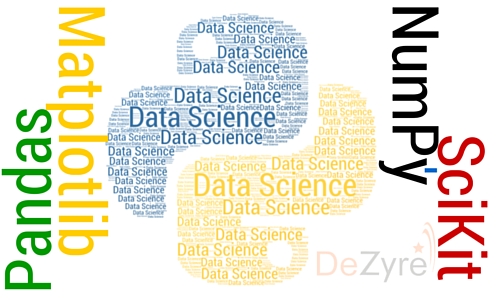Data Science Libraries in Python
 |
| Python Data Science |
Introduction
There is no doubt that the Python programming language has become the leading programming language in the field of data science and machine learning , and it has become one of the languages required as a condition in job opportunities ,and jobs related to data science and analysis.
The following figure represents the relationship between programming languages known and functions announced at the site indeed ,so that these functions was related to machine learning and Data Science , and the shape is clear to us that the Python language of top programming languages in these areas.
 |
| Python and other languages
The above gives a clear indication of the direction of skills and languages required in the functions of data science and machine learning , and in this article I will give you a quick and very brief about the most important overview of Python libraries in science data and machine learning , which should you have to you speak ,when your business functions such as data analyst Or a data scientist or in the field of machine education. The first Python Data Science library NumpyThe Numpy library is considered one of the basic mathematical libraries in scientific computing in Python, as many scientists and researchers rely on it to perform large ,and complex calculations on their data and in their scientific tests. The Numpy library has the following features:
Some library learning resources:
The second Python Data Science library PandasPandas library provides the necessary capabilities to make data analysis and processing easy and fast, through what it provides of structures and software tools based mainly on Numpy . Features and characteristics of the Pandas library:
And many other features and advantages. Some library learning resources:
The third Python Data Science library, ScipyThis library comes at the top of the pyramid of scientific libraries in Python, and serves the aspect of data analysis and machine learning strongly, and is not limited to that, as it provides huge capabilities in the field of signal processing, image processing, and complex mathematical operations. The Scipy library is based on a mixture of popular libraries such as Numpy, Pandas, Matplotlib, Sympy , IPython , and others. The library offers a wide range of algorithms and scientific packages ,that are particularly (but not limited to) mathematical operations, also statistical functions and machine learning. The Scipy library features:
And many other features and advantages. Some library learning resources:
Fourth Python Data Science library MatplotlibThis library one of the most Python libraries in the Visualization, and enables you to build your graphics graphs and illustrations are easy and flexible, also this library in several libraries and other tools ,including a library and linked Pandas tool Jupyter , to let you call the graphics commands directly on the frame data and interactive way. The flexibility in the library enables you to arrange shapes and graphics in an easy and convenient way, and you can also export the output as files in multiple formats, including Pdf, Jpg, SVG, PNG, BMP, GIF and others. Some library learning resources:
Fifth Python Data Science Library Scikit-learnThis library is considered one of the most important libraries for machine learning in the Python language ,and is based on the previous library Scipy. Also this library provides users with a set of machine learning algorithms and makes it easy for them to run and implement these algorithms directly on the data. The following link lists the algorithms for machine learning that are in the library here Some library learning resources:
summaryThe previous libraries are not the only ones in data science and machine learning in Python ,but they are distinguished and widely used among scientists and researchers in this field. If you have the basics of the Python language, and you want to start specializing in the field of data science and analysis or machine learning ,so I advise you to master the use of these libraries for their power and wide use. |
Read Also :

Comments
Post a Comment